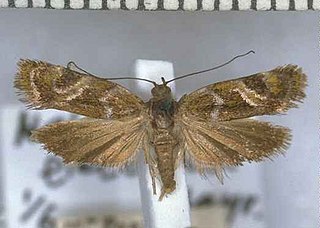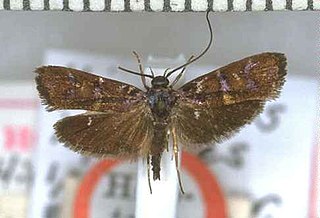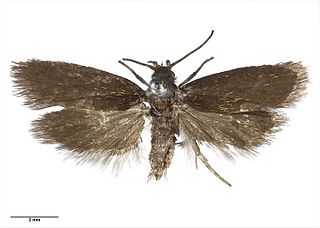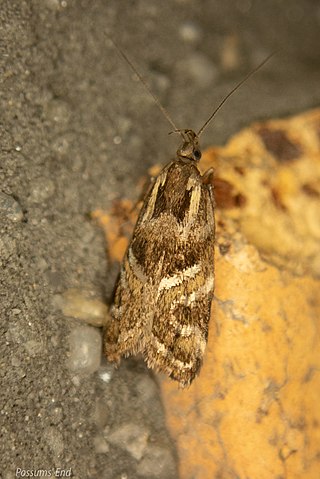Izatha oleariae is a species of moth in the family Oecophoridae. It is endemic to New Zealand. This species is classified as "At Risk, Naturally Uncommon" by the Department of Conservation. It is only found on the Snares Islands.

Ichneutica petrograpta is a moth of the family Noctuidae. This species is endemic to New Zealand where it is found in the southwest districts of the South Island, including Westland, Otago Lakes and Fiordland. It is very similar in appearance to I. mutans. It inhabits tussock and shrubland in the alpine to subalpine zones. Adults of I. petrograpta are on the wing from December to February and are attracted to sugar traps. The life history of this species is unknown as are the host species of its larvae.

Hierodoris atychioides is a moth of the family Oecophoridae. It was described by Arthur Gardiner Butler in 1877. The female holotype specimen held at the Natural History Museum, London. This species is endemic to New Zealand, and can be found in the North, South and Stewart Islands. The larvae form webs of silk attached to frass and leaves on their hosts in which they shelter, often in the company of other larvae in their species. Their feeding habits have not been observed in detail but Hoare hypothesises the larvae may feed on dead or dying leaves. The larvae feed on a wide range of trees and shrubs, including Dacrydium cupressinum, Prumnopitys taxifolia, Dacrycarpus dacrydioides, Libocedrus bidwillii, Cupressus macrocarpa, Leptospermum scoparium, Kunzea ericoides, Ozothamnus leptophyllus, Abies, Picea, Pinus and Thuja species. Although they are regarded as a pest of exotic forests in New Zealand, the economic damage the larvae cause is minimal and they tend to be controlled only by their natural enemies. Larval enemies include the parasitic flies Trigonospila brevifacies and Pales funesta as well as parasitic wasps including Xanthopimpla rhopaloceros. The adult moths are day flying and are most common during the months of December and January. This species is variable in appearance as larvae, pupa and as adults, and it has been hypothesised that it is in the process of speciation.

Hierodoris illita is a moth of the family Oecophoridae. It is endemic to New Zealand and is found in both the North and South Islands. However this species has not been recorded at Stewart Island / Rakiura.

Hierodoris electrica is a moth of the family Oecophoridae. It was described by Edward Meyrick in 1889. It is endemic to New Zealand, where it has been reported from the northern and southern parts of the South Island. The larva of H. electrica has yet to be described. The wingspan is between 15 and 16.5 mm. The ground colour of the forewings is dark brown, with narrow yellow scales overlaying this base colour. The hindwings are brown. The known larval host species is Olearia nummulariifolia.

Hierodoris iophanes is a moth of the family Oecophoridae. It was described by Edward Meyrick in 1912. This species can be distinguished from others in its genus by the purple metallic colouration as well as the blue-white mark on its forewings. It is endemic to New Zealand, where it has been recorded from Auckland to Southland. This species inhabits native forest or scrub, with the adults preferring open glades. They are known to be on the wing from November until February and fly during daylight hours, being active on hot sunny days. Larvae feed on the interior of twigs of Prumnopitys ferruginea. The twigs had evidence of oviposition scars of cicadas and the larvae were collected in October after reddish-brown frass indicated their location within the twigs.
Hierodoris torrida is a species of moth in the family Oecophoridae. This species is endemic to New Zealand and can be found in the southern parts of the North Island, in Rangitikei and Wellington, and in the east of the South Island, in the Marlborough Sounds, Kaikōura, Mid and South Canterbury. The larvae of this species is unknown as is much of the biology of this species and its larval hosts. The adult moth prefers lowland forest habitat. It is classified as "At Risk, Relict'" by the Department of Conservation.

Hierodoris bilineata is a species of moth in the family Oecophoridae. It is endemic to New Zealand. This species is classified as "At Risk, Naturally Uncommon" by the Department of Conservation. It is possible that this species gives birth to live young rather than lay eggs as is the norm.
Hierodoris extensilis is a species of moth in the family Oecophoridae. It is endemic to New Zealand and is only found in Fiordland where it has been collected from Mount Titiroa and Mount Burns. It occurs in granite sand plains and gravel field habitat and has been collected in early February. As at 2012 the host plant of the larvae of this species is unknown but it has been hypothesised that the larvae may feed on plant roots given the long ovipositor of the female. This species is classified as "At Risk, Naturally Uncommon" by the Department of Conservation.

Hierodoris polita is a species of moth in the family Oecophoridae. It is endemic to New Zealand and is found only in the Central Otago region and in the Dunedin area. As at 2005 the larvae have yet to be identified. However it is possible that a specimen may have been collected in leaf litter thus leading to the hypothesis that the species may be a detritivore. The adults of this species prefer open habitat and have mainly been collected on south-facing rocky bluffs. The adult moths are on the wing in October, November and January to March. This species is classified as "At Risk, Naturally Uncommon" by the Department of Conservation.

Hierodoris tygris, also known as the Titirangi Tyger, is a species of moth in the family Oecophoridae. It is endemic to New Zealand and is found in the Auckland and Wellington regions. The larvae of this species is unknown as are the larval host species. Adults have been found on the wing from December to March with one specimen collected in early May. It is a nocturnal species that is attracted to light and has been collected with the use of a mercury vapour lamp. This species is classified as "Not Threatened" by the Department of Conservation.
Hierodoris huia is a species of moth in the family Oecophoridae. It is endemic to New Zealand. It is only known from two sites in Titirangi that are approximately 1 to 2 km apart. H. huia is suspected to be a forest canopy-dweller. This species is on the wing in January. Although the adult moths are attracted to light it has been hypothesised that it is a diurnal species on the basis of the behaviour the species exhibit when light trapped. The species was named in honour of the extinct bird species, the huia, as well as the type locality of Huia Road, Titirangi. This species is classified as "Data Deficient" by the Department of Conservation.

Hierodoris callispora is a moth of the family Oecophoridae. It is endemic to New Zealand and can be found throughout the country from south of the Bay of Plenty. This species inhabits native beech forest. Adults of the species have been found where Muehlenbeckia is common. Adults have also been collected from the flowers of Kunzea ericoides. However the larval host is unconfirmed although it has been hypothesised that larvae of this species feed on Kunzea ericoides flowers. Adults of this species can be distinguished by its orange ruff that contrasts with its dark head and thorax. There is a colour form that exists that has orange scales and an orange coloured fringe on the hindwing. Adults have been collected in December and January and are day flying but are also attracted to light at night. A female specimen has been found with a larva in her oviduct suggesting that this species may give birth to larval young.

Hierodoris eremita is a moth of the family Oecophoridae. It is endemic to New Zealand and found in the areas around Aoraki / Mount Cook and Westland Tai Poutini National Park areas. This species inhabits alpine herbfields at altitudes of around 900–1400 m. Larvae are said to have been reared on the leaves of plants in the Celmisia genus. Pupation happens on the host plant. The adults of this species is on the wing between December and June. This species is day flying.

Hierodoris frigida is a moth of the family Oecophoridae. It is endemic to New Zealand and is only found in the South Island. This species is found in two parts of that island, the Nelson/Tasman area and the Mackenzie, Otago and Dunedin areas in the southern part of the island. Although similar to H. iophanes this species can be distinguished as H. frigida has white bands on its forewings and the metallic coloured areas differ in placement. Segment 2 on the labial palp is entirely yellow and enables this species to be distinguished from the similar appearing species H. polita and H. torrida. Larvae have been collected amongst leaf litter from beneath species within the genus Thymus. It prefers open and shrubland habitats and adult moths have been observed flying close to the soil underneath Leptospermum scrub.
Hierodoris pachystegiae is a moth of the family Oecophoridae. It is endemic to New Zealand and has only been collected at Kaikōura. The larval host are plants in the genus Pachystegia which is found only in the Marlborough region. The larvae of this species have yet to be described from life but the adults of this species are predominantly grey in colour. The forewings of this species have silver markings similar to that of H. electrica.

Hierodoris squamea is a moth of the family Oecophoridae. It is endemic to New Zealand and is found in the mountains of Fiordland as well as the Olivine Range in south Westland. This species has a wingspan of between 12 and 13 mm and can be distinguished from similar species as it is very small in size, has a reduced eyespot on its forewings, clearly visible through Scanning Electron Microscope preparations, and has orange-yellow scales overlaying its dark forewing. It prefers open country of tussock grasslands and herbfields at high altitudes. As at 2005 the larvae is unknown. Adults are on the wing in January.

Hierodoris s-fractum is a moth of the family Oecophoridae. It is endemic to New Zealand and can be found only in the southern parts of the South Island. The male is larger than the female. This species is very similar in appearance to H. eletrica however H. s-fractum has an interrupted silver S-mark on the forewing and longer labial palps. The larvae has not yet been described. Hoare hypothesised that the larvae of this species likely feeds on leaf-litter. The species seems to prefer open dry areas and can be found in native shrub and gorse.

Hierodoris insignis is a species of moth in the family Gelechiidae. It is endemic to New Zealand and has been found in the Nelson/Tasman districts. The larvae are leaf miners and are hosted by Celmisia species. Adults are on the wing in January. It is likely that this species belongs to another genus and as such this species is also known as Hierodoris (s.l.) insignis or 'Hierodoris' insignis.

Hierodoris stellata is a species of moth in the family Plutellidae. It is endemic to New Zealand and is found in Fiordland and Dunedin. This species has been found in coastal native forest. Larvae feed on Astelia flower-spikes and adults are on the wing in late December and January. It has been stated that this species belongs to the genus Charixena however this placement has yet to be published. As such this species is currently known as Hierodoris (s.l.) stellata or 'Hierodoris'stellata.















